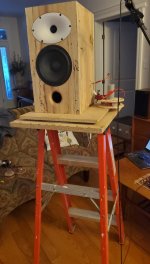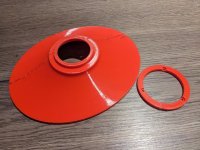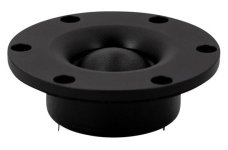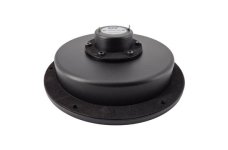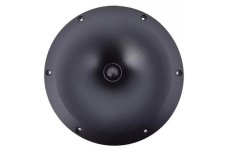In a video, the acetone wasn't applied directly to the part. The acetone was inside a bag with the part and the acetone vapor treated the part.
I don't know if that will work.
I have dipped golf club shaft ferrules in acetone and they look perfect!
I don't know if that will work.
I have dipped golf club shaft ferrules in acetone and they look perfect!
I used a container with a fan to distribute the vapor and it still wasn't a great process.
In my point of view, fdm 3d printer never gives perfect results and filament have often another color hue than the loudspeaker.
So I prefer to choose a rough print and use filler, primer if a very good finish is wanted.
So I prefer to choose a rough print and use filler, primer if a very good finish is wanted.
This is the stuff everyone seems to have the best luck with for smooth complex curves. It prevents faceting the surface, creating flat spots and ridges like with normal body filler and carding.
I also built a little acetone vapor box dedicated to 3D printed waveguides. It wasn't great. Filling, sanding, and painting was better.
I use the filler primer above (I don't love how it sands but it is easy and cheap to get from a big box store) and textured plastic spray paint below.

I use the filler primer above (I don't love how it sands but it is easy and cheap to get from a big box store) and textured plastic spray paint below.
The pic in my avatar has the SB21 4-inch waveguide painted. It also has two coats of flat or matte clear (I don't remember which, if was awhile ago.)
FAQ #67
How does the vertical directivity differ in an elliptical waveguide, vs a circular one?
Why would I choose one over the other?
How does the vertical directivity differ in an elliptical waveguide, vs a circular one?
Why would I choose one over the other?
I must be unusually obtuse this morning--could someone link an example of the router bit style to pair with the waveguide routing templates?
Or is basically any bit with a top mounted bushing fit for the task?
Or is basically any bit with a top mounted bushing fit for the task?
1/4" spiral bit and 5/16" and 1" template guide bushings
https://www.amazon.com/POWERTEC-710...a?sr=8-2-spons&sp_csd=d2lkZ2V0TmFtZT1zcF9hdGY
https://www.amazon.com/Whiteside-Router-Bits-RU2100-Standard/dp/B000K2BGNS/ref=sr_1_5_pp?sr=8-5
https://www.amazon.com/POWERTEC-710...a?sr=8-2-spons&sp_csd=d2lkZ2V0TmFtZT1zcF9hdGY
https://www.amazon.com/Whiteside-Router-Bits-RU2100-Standard/dp/B000K2BGNS/ref=sr_1_5_pp?sr=8-5
Thanks! No wonder I didn't follow the explanation--I've never used separate bushings like that, only bits with ball bearings on them.
I'm working on an OB project with a miniDSP Flex 8 used as active crossover. To start I'm going to make the slightly improbable leap of going from the SB26CDC tweeter to the SB 15OB350 15" driver, crossing around 1500 Hz or thereabouts. I might add a mid later, but for now, that's what the funds are.
I was going to 3D print the 8" oval waveguide, but thought I'd at least ask the question--would a 10" or even 12" WG make the directivity matching better?
Also, is the phase shield recommended? I don't think I understand what it actually achieves.
I was going to 3D print the 8" oval waveguide, but thought I'd at least ask the question--would a 10" or even 12" WG make the directivity matching better?
Also, is the phase shield recommended? I don't think I understand what it actually achieves.
Here we go with a trial.
The 8 inch for the tw29txn-b-8
I had a failure on main power so I did it in two parts but it doesn't match exactly and I had to solder both parts. Any way it is for prototyping.

I have change the back part and included a mounting ring. 3 little screws on the side are fixing the ring on the waveguide and the ring is fixed on tweeter with similarl screws than original.
Seing pics I am pretty sure SB acoustics is doing like that.


Now i have to dismantle a more than 250€ tweeter !
The 8 inch for the tw29txn-b-8
I had a failure on main power so I did it in two parts but it doesn't match exactly and I had to solder both parts. Any way it is for prototyping.
I have change the back part and included a mounting ring. 3 little screws on the side are fixing the ring on the waveguide and the ring is fixed on tweeter with similarl screws than original.
Seing pics I am pretty sure SB acoustics is doing like that.
Now i have to dismantle a more than 250€ tweeter !
Attachments
Greetings community!
Glad to join.
Have couple projects to try, but both needs waveguides.
Tweeters: SB Acoustics SB19ST-C000-4 and CSS LD25X Silk Dome XBL2. Is there any chance to get stl for them or any info/drawings?
There's waveguided version of CSS LD25X, but ridiculously expensive. I'd like to make them somehow.
Monacor WG-300 not available anymore, unfortunately...
Here's pictures of those waveguided CSS tweeters.
Glad to join.
Have couple projects to try, but both needs waveguides.
Tweeters: SB Acoustics SB19ST-C000-4 and CSS LD25X Silk Dome XBL2. Is there any chance to get stl for them or any info/drawings?
There's waveguided version of CSS LD25X, but ridiculously expensive. I'd like to make them somehow.
Monacor WG-300 not available anymore, unfortunately...
Here's pictures of those waveguided CSS tweeters.
Attachments
Any chance you would be interested in experimenting with fabricating a lens like that on the Seas 27TBCD/GB-DXT but for the T25? The Seas really has amazing directivity control across its range. It might be fun to try to replicate that for another tweeter.
- Home
- Loudspeakers
- Multi-Way
- Open source Waveguides for CNC & 3D printing!
